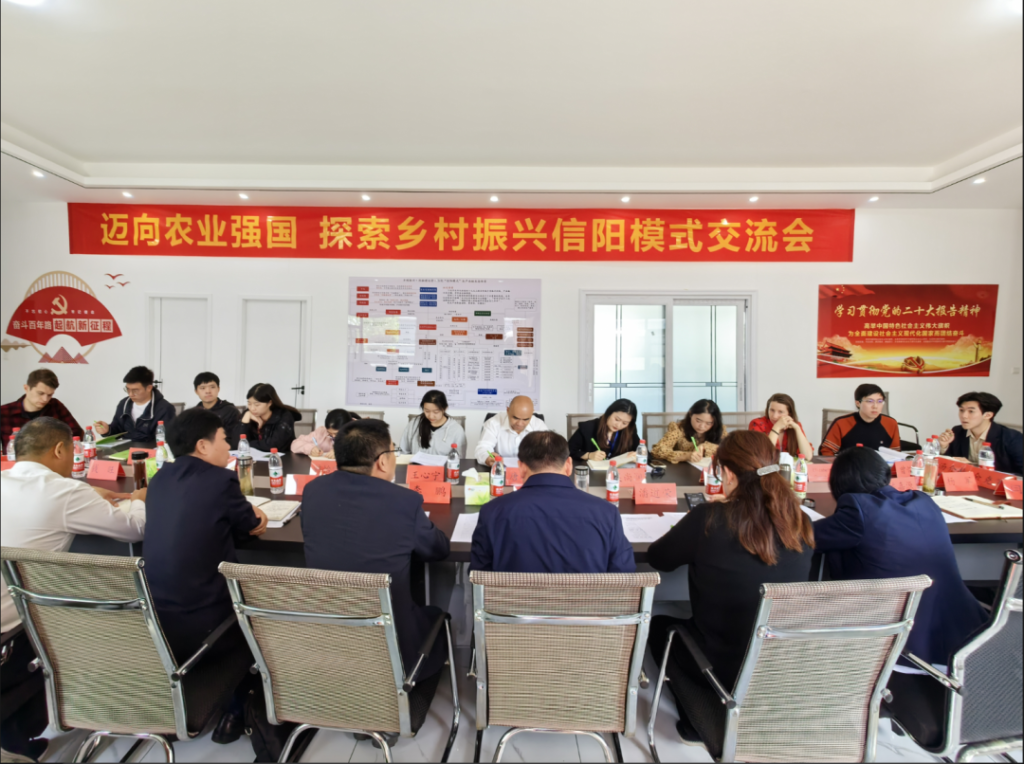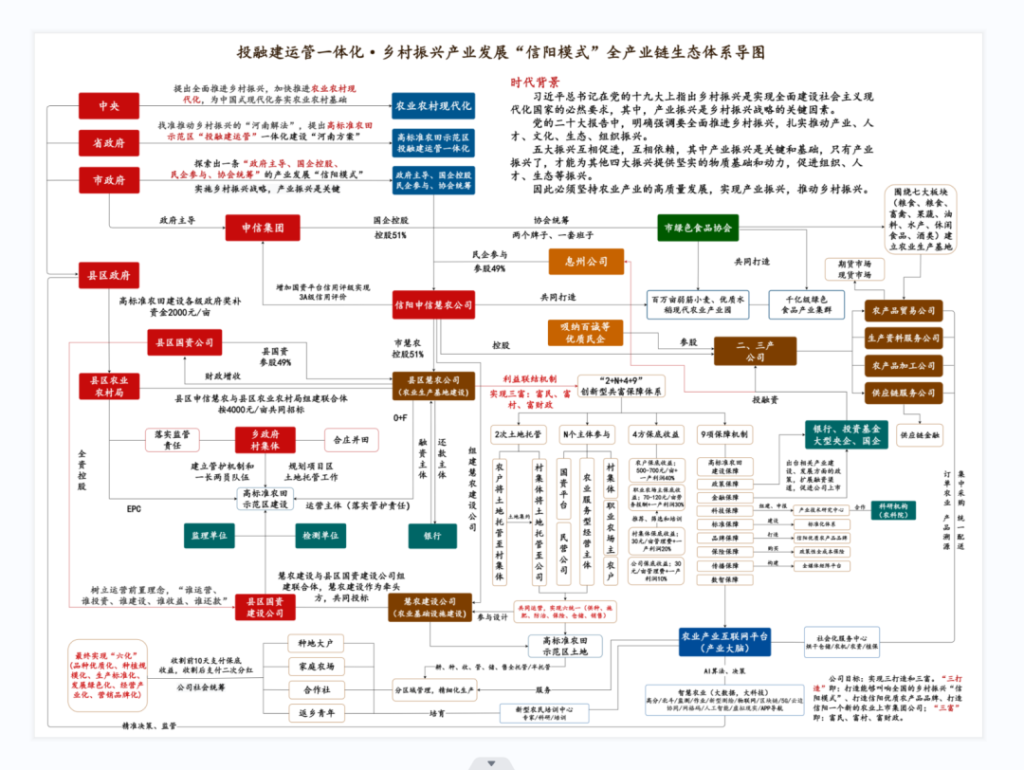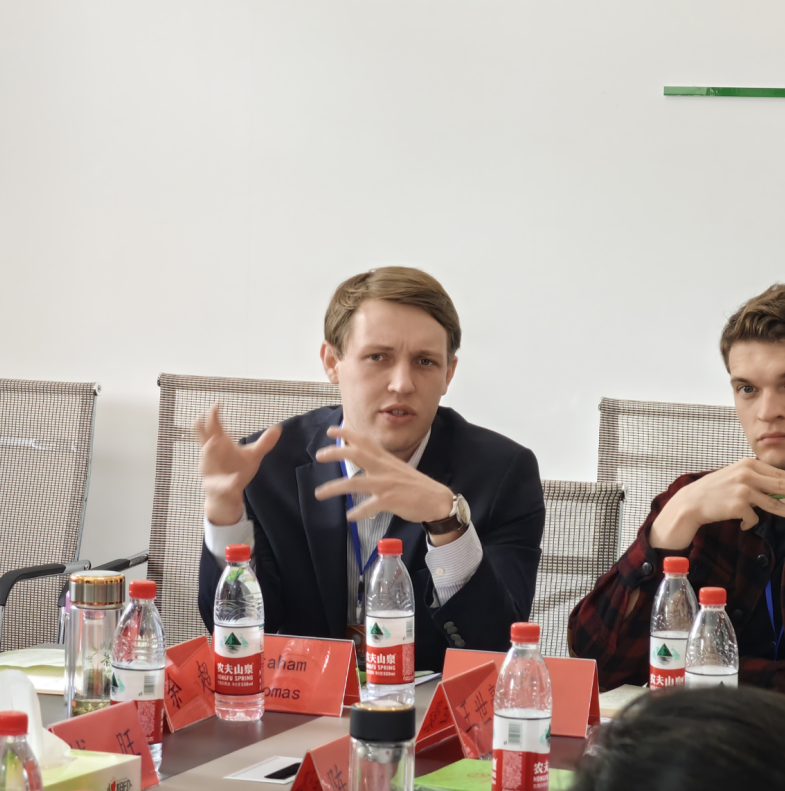By the Tsinghua-SAIS Dual Degree Program

Xinyang Model
On April 16, 2023, Professor Tang and members of Tsinhua-SAIS dual degree program participated in the seminar regarding Xinyang model of rural revitalization. In this seminar, Liu Qingdong, head of Pingqiao District, Li Peng, director of Xinyang Agricultural and Rural Bureau, Liu Hui, from Xinyang Rural Revitalization Bureau, Chen Jiayuan, deputy head of Pingqiao District, Wang Rongxiu, representative of the 14th National People’s Congress attended the seminar.
Sun Dehua, chairman of Xinyang Shenxin Huinong Agricultural Development Co., Ltd., and Pan Daorong, chairman of Xinyang Green Food Industry Association, introduced the “Xinyang Model”. Participants in this seminar had extensive communication on the development and prospects of the model, and visited Wuli Town in Pingqiao District.
Model Framework

The General Secretary pointed out that “industrial revitalization is the top priority of rural revitalization, and we should adhere to precise efforts, base on characteristic resources, pay attention to market demand, develop advantageous industries, promote the integrated development of one, two, three industries, and benefit rural farmers more and better. Industrial revitalization is the main direction to deeply implement the rural revitalization strategy and accelerate the modernization of agriculture and rural areas in the new development stage, while giving full play to the role of characteristic resources and market mechanism, promoting the better development of industries in line with resource endowment and comparative advantages, showing the expanded effect of integration of three industries, while keeping in mind the timely and reasonable distribution of benefits and protecting the rights and interests of farmers are the methods, paths and work guidelines clearly defined by the General Secretary. In the face of constraints and challenges, to do a good job of industrial revitalization, it is necessary to gather the enthusiasm and creativity of the farmers, and to let the dividends formed by development better benefit the farmers. This is the most crucial issue on the road of rural revitalization.
The rural landscape, with small farmers and villages, has been the national condition of China for a long time. Land is the most critical means of production for rural and agricultural production, but it is also the most basic means of livelihood for farmers, especially in a country like China, where there are many people and little land. At the same time, economic development is inseparable from the expanded reproduction using scale effective use of resources. To use the advantages of scale that modern agricultural production relies on, it is necessary to realize the utilization of land first. Therefore, to develop modern agriculture and a more prosperous rural economy, it is urgent to limit the divisions between “small farmers” and “big markets” to incorporate innovation in agricultural production methods and business models. Additionally, finding a balance between protecting farmers’ rights and interests in the face of large-scale land management.
In Henan Xinyang, the model of land trust practiced by Shenxin Huinong Agricultural Development Co., Ltd. provides an important reference for solving the problem above. Custodianship refers to the agricultural operation mode in which farmers and other business entities entrust all or part of the operation links of agricultural production, such as cultivation, planting, management and harvesting, to capable agricultural production-oriented service organizations under the condition that they do not transfer their land management rights. The former provides the whole process of unified operation in aspects such as seed supply, fertilization, control, insurance, storage and sales. Land trusts differs from land management rights transfer in the following three aspects: First, the attributes of farmers’ management rights remain unchanged; second, the benefits generated in the trust operation are directly related to farmers, and farmers enjoy dividends for the increase in production and income; third, through the agreement, farmers can enjoy guaranteed income. In summary, the trusteeship model better protects farmers’ rights and interests by means of guaranteed income, and also more effectively bundles farmers’ interests with the income generated by large-scale operation, promoting enthusiasm in participation in modern management styles.
Model Mechanism

The “Xinyang Model” operates on the premise of a land trust, with each administrative village party branch leading a land trust cooperative. Farmers’ trust their arable land to the village land trust cooperative voluntarily at a certain price, and each cooperative then trusts the land to a county-level Huinong company set up by the city’s Shenxin Huinong Company, and the county-level Huinong. Companies then sign a contract with a professional planting team, which will be operated according to the planting area, together with the two village committees who screen and find local cultivators and other people willing to plant land under the trust. The “Xinyang Model” also organically links various aspects through “2+N+4+9” and “six unification”. The “2” refers to the two trusteeships from households to villages and from villages to companies; “N” refers to the participation of multiple entities in the construction, such as agricultural machinery and plant protection cooperatives, family farms, large planters, etc.; “4 ” refers to the four guaranteed returns of farmers, village collectives, professional farmers and Huinong Company; “9” refers to nine safeguards including policy, technology, wisdom, standards, communication, insurance, finance, branding and construction of high-standard farmland; “six unified The “six unified” refers to unified seed supply, unified fertilization, unified control, unified insurance, unified storage, unified sales, especially the use of insurance to solve the risk.
The “Xinyang model” fully combines top-level design, grassroots initiatives, state-owned capital holding and social capital participation, with municipal and county government support. The Green Food Association Industry has coordinated high-quality orders and resources of three industries and built an experienced operations team capable of large-scale planting. With both together, it can be said that the feasibility, sustainability and wider application of the “Xinyang Model” has a solid foundation and great potential.
Innovation and Difficulties

“Xinyang Model” is an innovative agricultural production and operation model, which has several significant innovations and difficulties. One of the innovations is that the Xinyang model focuses on enhancing the productivity and added value of the main agricultural industry, rather than relying on tourism and other side income to supplement it, and opens up a path of rural revitalization that is integrated with the national food security strategy. The realization of this path requires the joint efforts of the government, enterprises and all parties in society to improve the efficiency and quality of agricultural production and strengthen the brand building and marketing of agricultural products, thus realizing a virtuous cycle of farmers’ income increase and rural revitalization.
Another innovation is that the Xinyang model achieves specialization, scale and industrialization of grain production in one stroke, and promotes sustainable growth by integrating the supply chain. This model requires hiring professional planting teams to take charge of planting, management and marketing, as well as financial and technical support from the government and enterprises to ensure the smooth operation of the entire production chain and to improve the added value and market competitiveness of agricultural products.
However, there are several difficulties in the Xinyang model. First, the villagers’ existing land operation model requires comprehensive and meticulous coordination work, requiring government and enterprise support in terms of policy, technology, and funding, as well as the need to address the interests of villagers through reasonable agreements and arrangements. Secondly, to ensure higher income for villagers and operating profit that can pay off the initial infrastructure investment, the government and enterprises need to formulate a reasonable income distribution plan to ensure that the interests of villagers and enterprises are balanced. Finally, the replicability of Xinyang model in other regions is also a difficult issue, which requires the government and enterprises to flexibly develop local industrial development paths and models according to the resource endowment and market demand of different regions. At the same time, support and training in technology, management and marketing need to be strengthened to improve the comprehensive quality and innovation ability of local farmers in order to promote the sustainable development of the agricultural industry.
In summary, the Xinyang model is an innovative and forward-looking agricultural production and operation model, which has important significance and value in improving agricultural production efficiency, promoting farmers’ income and promoting rural revitalization. However, realizing the comprehensive promotion and replication of Xinyang model requires the joint efforts of the government, enterprises and all parties in society to overcome difficulties and challenges to encourage vitality and momentum in the development of rural industries.